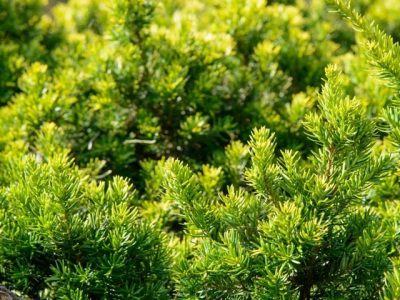How to Grow Japanese Yew Shrubs

Native to Japan and Korea, Japanese yews (Taxus cuspidata) were first introduced to North America by George R. Hall. Since the shrub species’ introduction, many cultivars have become available. All yews have needles and seeds that are highly toxic to humans and many animals, including dogs, cows and horses. For many years in England, the plants could only be planted in fenced churchyards – inaccessible to livestock. Avoid planting them if you have children or livestock nearby.
Although Japanese yews are technically classified as conifers, they don’t produce cones, but female specimens bear red berries. Japanese yews are versatile shrubs that serve a variety of purposes. Small cultivars make an attractive ground cover. Although yews are slow growing, they usually have a wide spread and will eventually fill in a large area, suppressing weed growth. Small Japanese yew species can prevent soil erosion on a slope or bank, or scramble over a wall or rock garden. Larger varieties make excellent specimen plants, especially in a formal garden. They can be pruned lightly to maintain shape and size or sheared for a trim look.
PLANTING JAPANESE YEWS
Japanese yews are more cold-hardy than many evergreen shrubs, thriving in U.S. Department of Agriculture plant hardiness zones 4 through 7. Plant Japanese yews from nursery transplants, which are often patented cultivars. Place these shrubs in full sun to partial shade. In areas with hot summers, they do best in a location with morning sun and afternoon shade. In areas with harsh winters, plant them in a protected spot, such as next to a house or wall or among other shrubs.
Japanese yews prefer a light, sandy soil on the acidic side. They do not tolerate heavy clay soils that don’t drain well. Amend the soil before planting with compost, manure or peat moss to improve drainage. If your soil is very wet or heavy, consider growing Japanese yews in raised beds or selecting a different plant.
Plant Japanese yews in spring. Dig a hole as deep as the root ball and twice as wide. Place the plant in the hole, making sure it’s straight. Fill the hole partially with water and add 2 gallons of water. Let the water drain and add the remaining soil, tamping it down with your foot. Water the plant at least weekly, especially during the first season as its roots become established. Although Japanese yews can’t tolerate soggy soils, they respond poorly to drought. Keep the soil slightly moist for best results.
Prune Japanese yews in spring or summer to remove dead branches and control the shrubs’ size. Fertilize the shrubs in early spring with ½ cup 10-10-10 fertilizer spread around the base of the plants. Japanese yew grows best with a soil pH between 6.0 and 6.5. In more acidic soils, the leaves may yellow. Lime the soil a season before planting to raise the soil pH.
PESTS AND PROBLEMS
The most common problem associated with Japanese yews is root rot caused by wet soils. If you choose a location carefully and amend the soil, you can likely avoid this issue. Japanese yews have very fragile bark. If the bark is damaged, branches above the injury may die back.
Scale, weevils and mealy bugs can infest Japanese yews, but the damage is rarely severe.
CULTIVARS WORTH TRYING
‘Capitata’ is really a tree, growing up to 50 feet tall with a conical form.
‘Densa’ is a low, spreading form that grows 4 feet tall and 8 feet wide.
‘Emerald Spreader’ grows only 2 ½ feet high, making it an ideal ground cover.
‘Nana’ has a low-growing, spreading form.
Related news
 How to handle fresh produce
How to handle fresh produce Instilling the importance of careful handling of fruit and vegetables is not as simple as it might seem.
 10 Organic Pest Control Methods
10 Organic Pest Control Methods If your vegetable garden is overrun with pests, the first step is to identify the invader. Snap a photo of the pest and compare to others on the internet
 The relationship between nitrogen & organic matter
The relationship between nitrogen & organic matter Vegetable growers frequently ignore the relationship between nitrogen and organic matter when deciding on the amount of nitrogen to apply to a crop